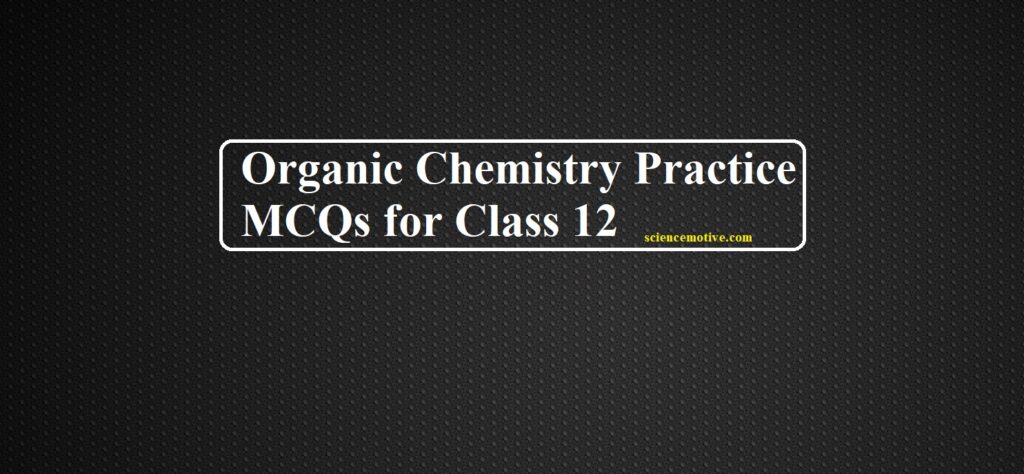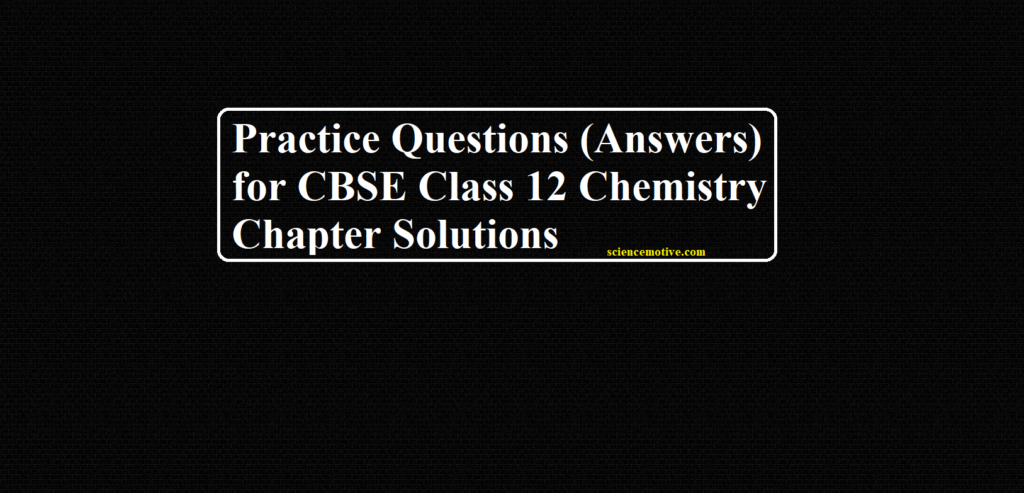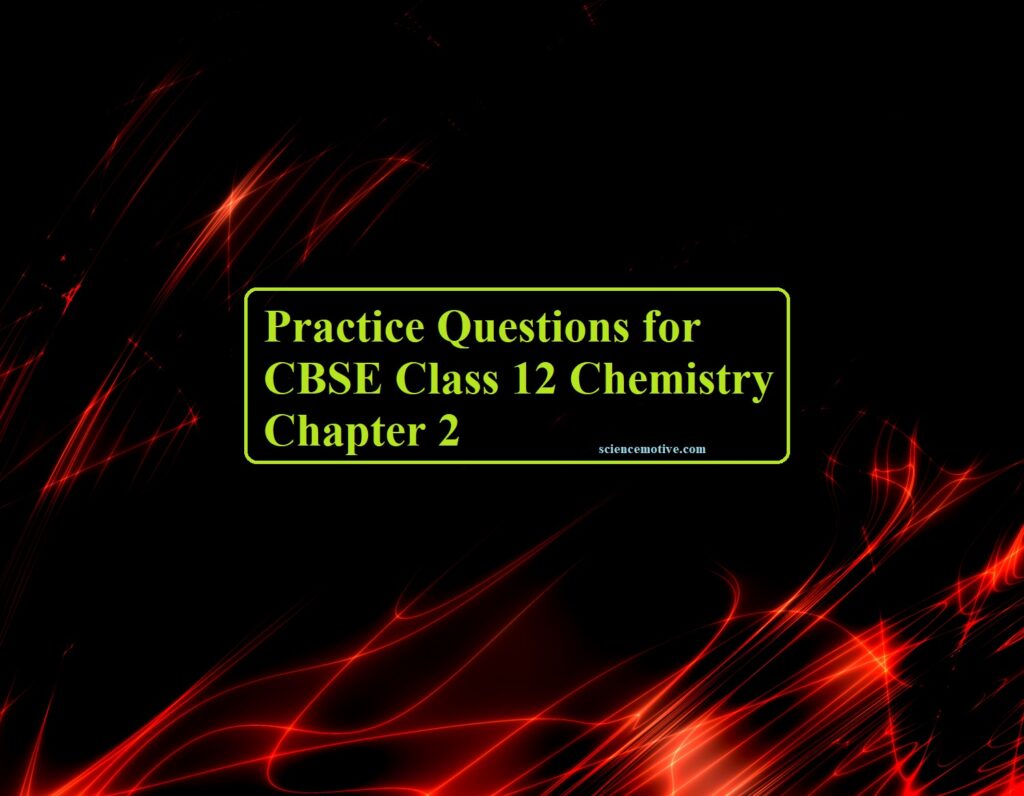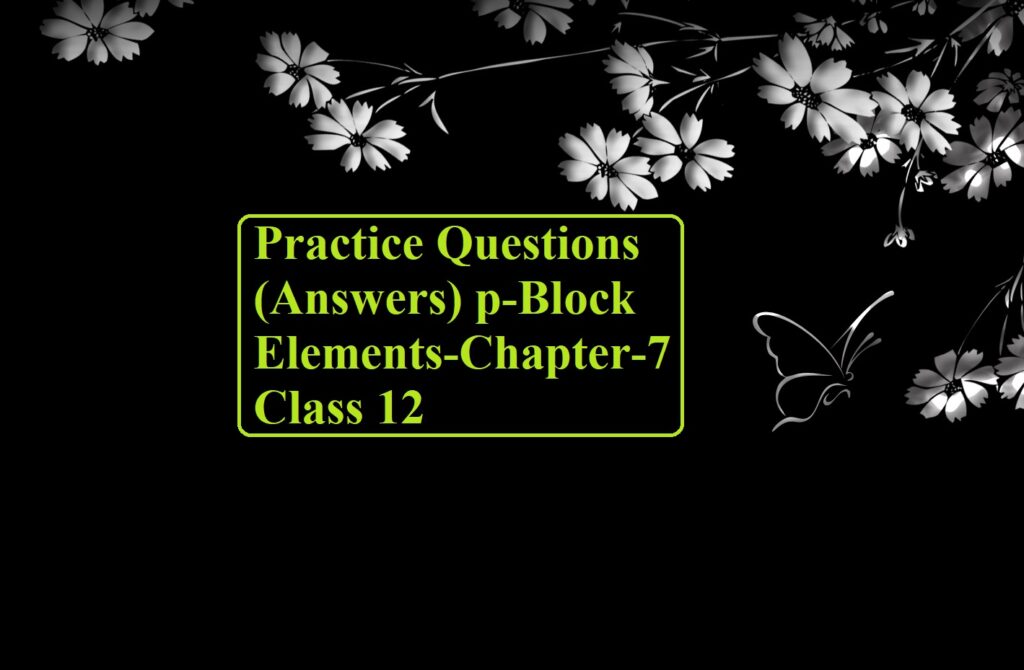Organic Chemistry Practice MCQs for Class 12
Organic Chemistry Practice MCQs for Class 12
Read the passage given below and answer the following questions:
Alkene hydration is a catalytic process that involves the addition of water across the double bond of an alkene to produce alcohol. This is the most direct and atom-economical approach to the synthesis of alcohols. Acid-catalyzed alkene hydration is the most well-known hydration process. This process is used industrially with several different acidic species as the catalyst, including zeolites, oxides, solid phosphoric acid, and sulfuric acid. There are several major drawbacks to this catalytic process. The first drawback is the acidic environment which is very corrosive and can lead to degradation of reactors or the need to use specially engineered and expensive reactors to resist the acidic conditions. Another drawback is the acidic environment required for hydration is not suitable for alkenes with acid-sensitive functional groups. Thus, this process is typically only used with simple alkenes such as ethylene, propylene, and butenes. The final and biggest drawback is the selectivity of the reaction. Acid-catalyzed hydration follows Markovnikov’s rule which states that the proton will add to the carbon with the most hydrogens attached to it. Therefore, starting with propylene, acid-catalyzed hydration will always be selective for internal alcohols (secondary or tertiary). Except for ethanol, primary alcohols cannot be synthesized by acid-catalyzed hydration. Generally, primary alcohols are the more valuable commodity industrially. Therefore, different synthetic strategies have to be invented for the synthesis of primary alcohols.
The following questions are multiple-choice questions. Choose the most appropriate answer:
Q 1. When Propene reacts with water under acidic conditions then the product is
(a) Propan-1-ol
(b) Propan-2-ol
(c) Propane
(d) Propanone
Q 2. Propyne on hydration in the presence of HgSO4 and Sulphuric acid will produce
(a) Propan-1-ol
(b) Propan-2-ol
(c) Propane
(d) Propanone
Q 3. 1-Methylcylohexene on hydration under acidic conditions will produce
(a) 1-Methylcyclohexan-2-ol
(b) 1-Methylcyclohexan-1-ol
(c) 2-Methylcyclohexan-2-ol
(d) 2-Methylcyclohexanone
Q 4. But-1-ene (P) on acidic condition hydration will produce ‘X’ compound, which on dehydration produce ‘Y’. Acidic condition hydration of ‘Y’ will produce ‘Z’. Then select the incorrect option
(a) X and Y are not isomers
(b) P and Y are position isomer
(c) X and Z are the same
(d) X on reaction with Na does not produce H2 gas
Q 5. Monochlorination of toluene in sunlight followed by hydrolysis with aq. NaOH yields.
(a) o-Cresol
(b) m-Cresol
(c) 2, 4-Dihydroxytoluene
(d) Benzyl alcohol
Organic Chemistry Practice MCQs for Class 12
Q 6. CH3CH2OH can be converted into CH3CHO by ______________.
(a) Catalytic Hydrogenation
(b) Treatment with LiAlH4
(c) Treatment with pyridinium chlorochromate
(d) Treatment with KMnO4
Q 7. The process of converting alkyl halides into alcohols involves_____________.
(a) Addition reaction
(b) Substitution reaction
(c) Dehydrohalogenation reaction
(d) Rearrangement reaction
Q 8. Which of the following compounds is aromatic alcohol?

(a) A, B, C, D
(b) A, D
(c) B, C
(d) A
Q 9. Which of the following species can act as the strongest base?

Q 10. Phenol is less acidic than ______________.
(a) Ethanol
(b) o-nitrophenol
(c) o-methylphenol
(d) o-methoxyphenol
Q 11. Which of the following is most acidic?
(a) Benzyl alcohol
(b) Cyclohexanol
(c) Phenol
(d) m-Chlorophenol
Q 12. Arrange the following compounds in increasing order of boiling point. Propan-1-ol, butan-1-ol, butan-2-ol, pentan-1-ol
(a) Propan-1-ol, butan-2-ol, butan-1-ol, pentan-1-ol
(b) Propan-1-ol, butan-1-ol, butan-2-ol, pentan-1-ol
(c) Pentan-1-ol, butan-2-ol, butan-1-ol, propan-1-ol
(d) Pentan-1-ol, butan-1-ol, butan-2-ol, propan-1-ol
Q 13. What is A in the following reaction

(a) CH3CHOHCH3
(b) CH3COCH3
(c) C2H5OH
(d) CH3COOH
Q 14. From Williamson’s synthesis preparation of which of the following is possible
(a) Only symmetrical ethers
(b) Only symmetrical ethers
(c) Both types
(d) None of these
Q 15. Order of reactivity of alcohols towards sodium metal is
(a) Pri > Sec > Ter
(b) Pri > Sec < Ter
(c) Pri < Sec > Ter
(d) Pri < Sec < Ter
Organic Chemistry Practice MCQs for Class 12
Note: In the following questions a statement of assertion followed by a statement of reason is given. Choose the correct answer out of the following choices.
(a) Assertion and reason both are correct and the reason is the correct explanation of assertion.
(b) Assertion and reason both are wrong statements.
(c) Assertion is a correct statement but the reason is a wrong statement.
(d) Assertion is the wrong statement but the reason is a correct statement.
(e) Both assertion and reason are correct statements but the reason is not a correct explanation of assertion.
Q 16. Assertion: Ethanol is a weaker acid than phenol.
Reason: Sodium ethoxide may be prepared by the reaction of ethanol with aqueous NaOH.
Q 17. Assertion: Like bromination of benzene, bromination of phenol is also carried out in the presence of Lewis acid.
Reason: Lewis acid polarises the bromine molecule.
Q 18. Assertion: Phenols give o– and p-nitrophenol on nitration with conc. HNO3 and H2SO4 mixture.
Reason: — OH group in phenol is o–, p– directing.
Q 19. Assertion: Tertiary alcohols give turbidity immediately with Lucas reagent.
Reason: A mixture of conc. HI + anhydrous ZnCl2 is called Lucas reagent.
Q 20. Assertion: Both symmetrical and unsymmetrical ethers can be prepared by Williamson’s synthesis.
Reason: Williamson’s synthesis is an example of a nucleophilic substitution reaction.
Q 21. Assertion: Glycine is amphoteric in nature.
Reason: Glycine contains both acid and basic groups.
Q 22. Assertion: Hydrolysis of sucrose is known as the inversion of cane sugar.
Reason: Sucrose is a disaccharide.
Q 23. Assertion: All Amino acids exist as Zwitter ions.
Reason: Amino acids have both -NH2 and -COOH groups/.
Q 24. DNA multiplication is called
(a) Translation
(b) Transduction
(c) Transcription
(d) Replication
Q 25. A biological catalyst is essentially
(a) An enzyme
(b) A carbohydrate
(c) An amino acid
(d) A nitrogen compound
Organic Chemistry Practice MCQs for Class 12
Q 26. Haemoglobin is
(a) An enzyme
(b) A globular protein
(c) A vitamin
(d) A carbohydrate
Q 27. Glucose has a difference from fructose in that it
(a) Does not undergo hydrolysis
(b) Gives silver mirror with Tollen’s reagent
(c) Monosaccharide
(d) None of these
Q 28. An example of non-reducing sugar is
(a) Cane sugar
(b) Fructose
(c) Lactose
(d) Cellobiose
Q 29. Cellulose is a polymer of
(a) L-fructose
(b) D-mannose
(c) D-glucose
(d) Amylose
Q 30. α-D (+) Glucose and β-D (+) glucose are
(a) Epimers
(b) Anomers
(c) Enantiomers
(d) Conformational isomers
Q 31. Which of the following amino acids is achiral?
(a) Alanine
(b) Leucine
(c) Proline
(d) Glycine
Q 32. A carbohydrate that cannot be hydrolyzed to simpler forms is called
(a) Disaccharide
(b) Monosaccharide
(c) Polysaccharide
(d) Trisaccharide
Q 33. If monosaccharide contains an aldehyde group, it is known as
(a) Epimer
(b) Osones
(c) Osazone
(d) Aldose
Q 34. The helical structure or a secondary structure of proteins is stabilized by
(a) Peptide bonds
(b) Dipeptide bonds
(c) H-bond
(d) Ether bond
Q 35. Which of the following is/are example(s) of denaturation of protein?
(a) Coagulation of egg white
(b) Curdling of milk
(c) Clotting of blood
(d) Both (a) and (b)
Q 36. Oxime is formed by treating glucose with
(a) Water
(b) Nitric acid
(c) Bromine water
(d) Hydroxylamine
Q 37. Glucose when reacted with HI and red phosphorus gives
(a) n-hexane
(b) n-heptane
(c) n – pentane
(d) n-octane
Q 38. Proteins are condensation polymers of
(a) Alpha-amino acids
(b) Beta amino acids
(c) Alpha hydroxy acids
(d) Beta hydroxyl acids
Q 39. Which of the following reagents does not react with glucose?
(a) NH2OH
(b) HCN
(c) 2,4 – DNP reagent
(d) Br2 water
Q 40. The number of chiral carbons in ß-D (+) glucose is
(a) Five
(b) Two
(c) Four
(d) Six
Organic Chemistry Practice MCQs for Class 12
To get answers click
ORGANIC CHEMISTRY PRACTICE MCQS (ANSWERS) FOR CLASS 12



